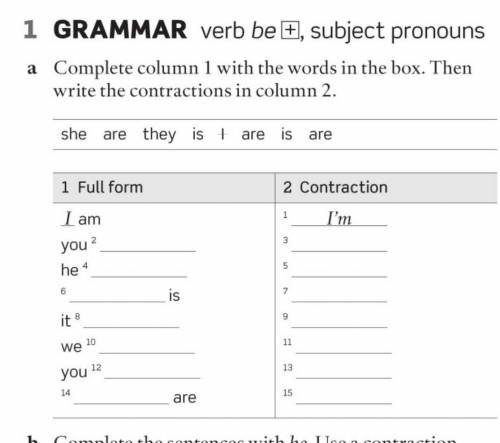1 GRAMMAR verb be+, subject pronouns a Complete column 1 with the words in the box. Then
write the contractions in column 2.
she are they is l are is are

Другие вопросы по теме Английский язык
Популярные вопросы
- Сократите дробь 9-х² в числителе х²+6х+9 в знаменателе...
1 - Длина басейна прямоугольной формы 25,м а ширина 13м найдите площадь и...
3 - Синоним до слова: захоплюючий и безмежний...
1 - Слон весит x кг сколько весят 5 таких слонов...
2 - Определить массовые доли элементов na2co3 w x2 - ?...
2 - Секреты письма подбери к одинаковым по звучанию словам проверочные одинаковые...
3 - Какую информацию можно получить при использовании климатической карты...
2 - Лексичне значення слова пояснюється: а в орфографічних словниках; б у...
1 - Внекоторой стране автомобильный номер является из заглавных букв всего...
2 - Вчем состоит взаимосвязь индивидуально-психологических и личностных качеств...
2
1. she is
2. they are
3. I am
4. you are
5. we are
6. he is
Column 2:
1. she's
2. they're
3. I'm
4. you're
5. we're
6. he's
Explanation:
The verb "be" is used to describe a state of being or existence. In this exercise, we need to match the correct subject pronouns with the correct form of the verb "be."
In column 1, we have a list of subject pronouns: she, they, I, you, we, and he. We need to match each of these subject pronouns with the correct form of the verb "be."
For example, when we have the subject pronoun "she," we use the form "is." So, "she" + "is" becomes "she is." That's why in column 1, "she" corresponds with "is."
Similarly, "they" + "are" becomes "they are," "I" + "am" becomes "I am," "you" + "are" becomes "you are," "we" + "are" becomes "we are," and "he" + "is" becomes "he is."
Now, in column 2, we need to write the contractions for each of the correct combinations. Contractions are shortened forms of two words. For example, "she is" can be shortened to "she's."
So, using the same examples as before, "she is" becomes "she's," "they are" becomes "they're," "I am" becomes "I'm," "you are" becomes "you're," "we are" becomes "we're," and "he is" becomes "he's."
By using these contractions, we can make our sentences shorter and more colloquial in spoken English.